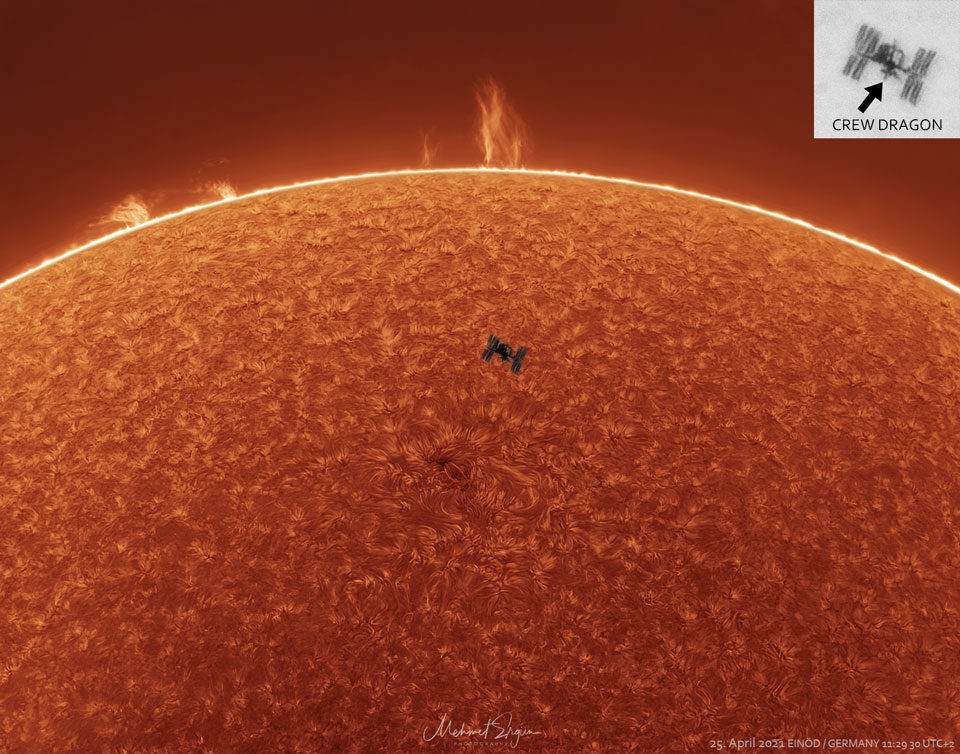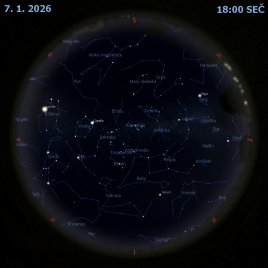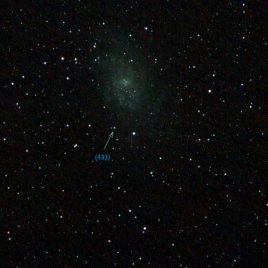Kosmická stanice, sluneční protuberance, Slunce

Uznání a copyright: Mehmet Ergün
To není
sluneční skvrna.
Je to
Mezinárodní kosmická stanice
(ISS) zachycená při průletu před Sluncem. Jednotlivé
sluneční skvrny
mají tmavou centrální
umbru,
světlejší okolní
penumbru,
ale
žádné připojené kabiny Dragon.
Naproti tomu
ISS
je složitý ježatý mechanismus, jedna z největších a
nejsložitějších kosmických lodí,
které kdy
lidstvo vytvořilo.
Sluneční skvrny také rotují
kolem
Slunce,
zatímco
ISS
obíhá kolem
Země.
Přechod přes Slunce není pro
ISS,
která obíhá kolem Země přibližně každých 90 minut, nijak výjimečný, ale trefit se do správné polohy, načasování a vybavení pro
skvělý snímek
je vzácné. Tento
snímek
kombinuje tři expozice pořízené v roce 2021 ze stejného místa a téměř ve stejný čas.
Jeden přeexponovaný snímek zachytil slabé
protuberance
viditelné na Slunci nahoře, druhý podexponovaný snímek zachytil složitou strukturu
sluneční chromosféry
a třetí nejhůře dosažitelný snímek zachytil kosmickou stanici ve zlomku sekundy, když zrovna
přelétala přes
Slunce. Při
podrobné
prohlídce
siluety
kosmické stanice je dokonce vidět zakotvená
kabina Crew Dragon.
Oprava: Na překlep ve slově přelétala upozornil Petr Zoufalý.
Seznam odkazů v popisu
- Youtu.be: That's no moon. It's a space station.
- APOD: 2016-04-18 Mezinárodní kosmická stanice nad Zemí
- APOD: 2005-11-06 Sluneční skvrna podrobně
- NASA: sunspot_dia.gif
- APOD: 2006-09-09 Stínohra
- PetsWorld.in: Foto: přemýšlivý pes :-)
- NASA: International Space Station
- NYTimes.com: How the Space Station Became a Base to Launch Humanity’s Future
- APOD: 2019-08-18 Člověk jako kosmická loď
- APOD: 2014-10-22 Sršení skupiny slunečních skvrn AR 2192 Crackles
- NASA: The Sun
- APOD: 2016-11-05 Průlet ISS rybím okem
- APOD: 2022-02-06 Modrá skleněná kulička Země
- APOD: 2005-07-29 Přechod ISS a Discovery přes Slunce
- APOD: 2017-08-28 Prchavé dvojité zatmění Slunce
- Instagram.com: mehmet.erguen: ???????? Vor 2 Wochen geplant, 35KG Equipment, ca 300 KM Autofahrt, ca 10 Stunden Zeit Aufwand.. Alles nur für 1 Sekunde!! Die ISS Transit von heute (25.04.2021) Das Teilen ist natürlich erlaubt! Viele Grüße. Mehmet Ergün
- APOD: 2016-03-06 Sluneční protuberance z SDO
- NSO.edu: Chromosphere
- APOD: Chromosphere.mp4
- Buenavet.com: Foto: Kočka s rybičkou :-)
- APOD: 2014-08-03 Temný raketoplán se přibližuje
- Wikipedia: SpaceX_Dragon_2
NASA Official: Phillip Newman Specific rights apply. NASA Web Privacy Policy and Important Notices
A service of: ASD at NASA / GSFC & Michigan Tech. U.
Odkaz na originální APOD


